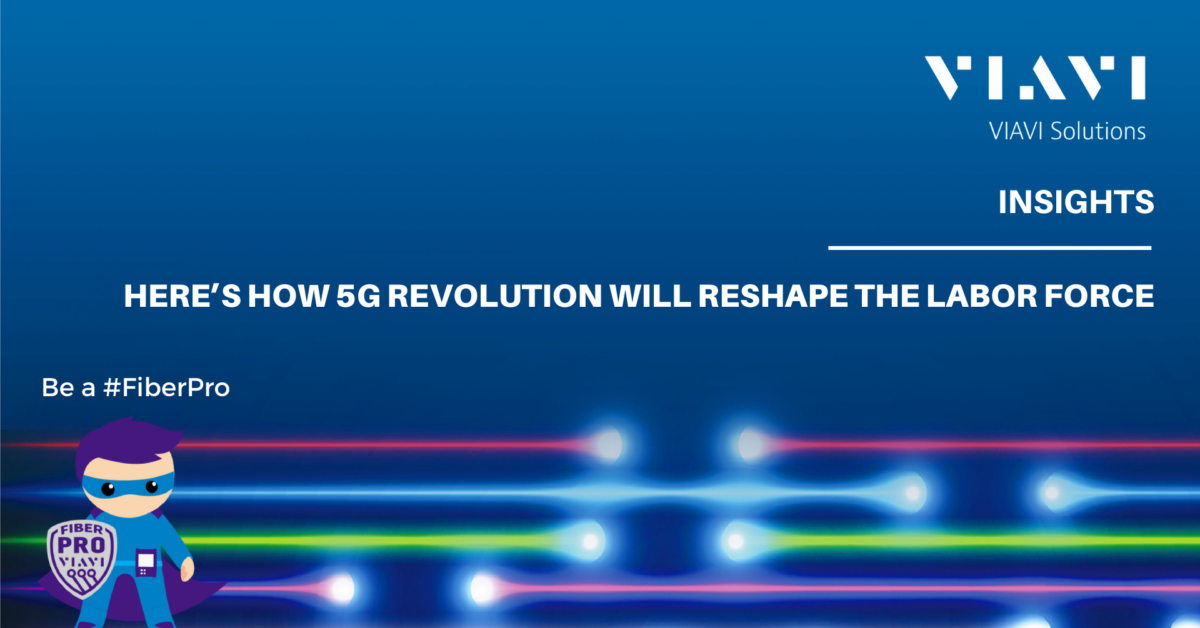Here’s How 5G Revolution Will Reshape The Labor Force

The adoption of newer technologies such as 5G will not only act as a positive catalyst for opportunities in the telecom sector, but it will have a ripple effect across many industries. It will unleash an unprecedented level of change in the workplace – from transforming employee interaction to banishing the traditional 9-5 job, the adoption of 5G network is expected to completely transform the idea of the workplace that we know of today.
Here is the impact of the 5G Revolution on the labor force:
Accelerated Job Creation & Growth
A recent study prepared for the National Spectrum Consortium has unveiled groundbreaking findings that the 5G transition will create 4.6 million jobs in the US by 2034 to fuel a new wave of mobility and innovation. Globally, 5G is estimated to support 35 million jobs by 2035, according to a study by IHS Markit. The former study also revealed that the current 5G preparation and engineering activities has already created 106,000 new jobs as of April/May 2020 in the US alone. This could translate to even bigger opportunities and jobs created when we account for leading countries, such as China, Japan, and South Korea.
The first and most direct impact of 5G will be seen by the telecommunications industry and those related with the construction of 5G infrastructure. With the rollout of 5G currently underway, we can expect to see up to 63% more jobs to build out network infrastructure, adding up to more than 350,000 new construction jobs and a total of 850,000 jobs in the US. The 5G transition will also have a positive impact on the telecom professionals in the field, especially for those who are focusing on newer technology adoption. Billions of connected devices mean thousands of skilled technicians will be needed to install, sustain, and maintain these networks. For instance, the increased adoption of optical fiber replacing the copper cable will increase the demand for more splicers & engineers, as they have the required expertise with maintaining fiber.
The next wave of jobs creation will generate new sets of occupations, such as smart grid analyst, robotics maintenance, drone operator, and telehealth installer. These new jobs will likely require an entirely new skill-set, and in some cases it might require a skill that doesn’t yet exist. It is important for both companies and individuals to continuously upskill and retrain, focusing on skills in emerging fields such as machine learning and robotics.
Major Shift to Remote Work
Perhaps one of the most highly anticipated transitions will be remote work. After all, remote working has been proven to be beneficial for both employers and employees, as long as they are prepared and have the requirements. Before we encountered the Covid-19 global pandemic, remote working has been enjoyed exclusively by the white collar workforce. This is because it requires a reliable high-speed internet and decent working space free from distractions, thus such work is very limited and nearly impossible for many people. Moreover, the opportunity for working remotely is close to none for blue collar workers and those in the service industry, as their physical presence is required in the workplace.
However, with 5G’s enhanced speed and combined with other infrastructure such as 5G, IoT, and VR, all of this will change. Workers will truly be able to work from anywhere they want – whether that’s at home, in a park, or in a train – and that applies to blue collar and service workers, too. Essential workers, such as health care professionals will be able to monitor patient health at lengthy, laggy, and buggy connections during a group conference call can be a sure-fire way to lose focus during real-time through wearable devices, thus optimizing their time while minimizing their risk.
Enhancing Employee Interaction and Collaboration
One of the problems with remote work is slow internet during virtual meetings. A recent survey has claimed that the biggest detractors of video meetings are technical difficulties and poor audio quality, i.e. echoing sound. However, as 5G networks become the backbone of digital connectivity, virtual meetings will be just as smoothly as in-person ones. Over this high-speed internet, video conferencing will be crisper, quicker, and easier to access, thus reducing user frustration with network issues and fostering greater trust in businesses.
Since 5G is faster and more responsive, virtual reality (VR) and augmented reality (AR) may become more mainstream, thus enabling employees to interact and collaborate with their colleagues in many ways. Using the combination of 5G, VR, AR, and supporting tools, such as digital whiteboard or 5G-enabled holographic calls, virtual meetings would be indistinguishable from the real-life one. Employees may no longer need to go overseas to handle business matters – instead, they can collaborate from home.
Inevitably, this new generation of network will pave the way for greater innovation, one of them being collaboration innovation. Collaboration tools will play a significant role in maintaining the distributed workforce connected and productive. AI and machine learning is predicted to play a more pivotal role in workplace collaboration. Real-time, accurate, and automated language translation will soon be the norm, thus enabling employees from different countries and languages to seamlessly collaborate in one project. These anticipated 5G-powered innovations will allow for even more people to enter and thrive in the remote workforce.
Final Thoughts
With remote work already on the rise using 4G networks, there’s no question that the future of the workplace is firmly rooted in 5G. While the exciting scenarios above are still unlikely to happen in the near future, we still need to prepare ourselves and be prepared to be early adopters for 5G. The key to a winning strategy is to futureproof your infrastructure and have the right solutions for maintaining your networks.
Since 2013, VIAVI Solutions has been an early driver in 5G adoption and we continue to deliver innovative and cost-effective 5G testing tools to customers. Check out our comprehensive portfolio of 5G Test and Verification Solutions and learn what makes VIAVI a stand out amongst other 5G testing companies. VIAVI’s umbrella of interactive tools, testing capabilities, and solutions will help you to thrive, whichever industry or region you’re working within.



